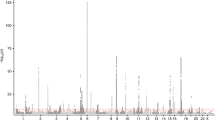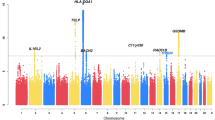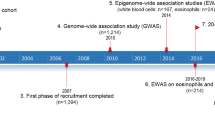Abstract
CX3CR1, a fractalkine receptor, mediates cell-adhesive and migratory functions in inflammation. Based on CX3CR1 expression observed in bronchial tissues of asthmatic subjects, we hypothesized that genetic variation at this locus may affect susceptibility to asthma. We carried out an association study and a haplotypic analysis with selected polymorphisms of the CX3CR1 in a familial asthmatic sample from a founder population. Genetic analyses performed by FBAT software showed five CX3CR1 single nucleotide polymorphisms (rs938203, rs2669849, rs1050592, T280M and V249I) with significant associations between their common alleles and asthma (P<0.004) in a dominant model. A haplotype formed with common alleles of rs1050592, T280M and V249I is also overtransmitted in asthmatic subjects (P=0.005) under a dominant model. The associations of V249I and rs2669849 have been validated in an independent case–control sample. For V249I, odds ratios (OR) are 2.16 (common homozygous) and 2.11 (heterozygous) in dominant model (P=0.031). For rs2669849, OR are 2.75 (common homozygous) and 1.86 (heterozygous) in additive model (P=0.007) and dominant model (P=0.059). These results suggest an asthma protective effect of the minor alleles in healthy control carriers. Further functional studies of CX3CR1 are needed to document its role in the pathophysiology of asthma.
This is a preview of subscription content, access via your institution
Access options
Subscribe to this journal
Receive 6 digital issues and online access to articles
$119.00 per year
only $19.83 per issue
Buy this article
- Purchase on Springer Link
- Instant access to full article PDF
Prices may be subject to local taxes which are calculated during checkout


Similar content being viewed by others
Accession codes
References
Maddox L, Schwartz DA . The pathophysiology of asthma. Annu Rev Med 2002; 53: 477–498.
Cookson WO, Moffatt MF . Genetics of asthma and allergic disease. Hum Mol Genet 2000; 9: 2359–2364.
Howarth PH, Wilson J, Djukanovic R, Wilson S, Britten K, Walls A et al. Airway inflammation and atopic asthma: a comparative bronchoscopic investigation. Int Arch Allergy Appl Immunol 1991; 94: 266–269.
Bousquet J, Jeffery PK, Busse WW, Johnson M, Vignola AM . Asthma. from bronchoconstriction to airways inflammation and remodeling. Am J Respir Crit Care Med 2000; 161: 1720–1745.
Ober C, Hoffjan S . Asthma genetics 2006: the long and winding road to gene discovery. Genes Immun 2006; 7: 95–100.
Laprise C, Sladek R, Ponton A, Bernier MC, Hudson TJ, Laviolette M . Functional classes of bronchial mucosa genes that are differentially expressed in asthma. BMC Genomics 2004; 5: 21–31.
Maho A, Bensimon A, Vassart G, Parmentier M . Mapping of the CCXCR1, CX3CR1, CCBP2 and CCR9 genes to the CCR cluster within the 3p21.3 region of the human genome. Cytogenet Cell Genet 1999; 87: 265–268.
Fong AM, Robinson LA, Steeber DA, Tedder TF, Yoshie O, Imai T et al. Fractalkine and CX3CR1 mediate a novel mechanism of leukocyte capture, firm adhesion, and activation under physiologic flow. J Exp Med 1998; 188: 1413–1419.
Imai T, Hieshima K, Haskell C, Baba M, Nagira M, Nishimura M et al. Identification and molecular characterization of fractalkine receptor CX3CR1, which mediates both leukocyte migration and adhesion. Cell 1997; 91: 521–530.
Combadiere C, Salzwedel K, Smith ED, Tiffany HL, Berger EA, Murphy PM . Identification of CX3CR1. A chemotactic receptor for the human CX3C chemokine fractalkine and a fusion coreceptor for HIV-1. J Biol Chem 1998; 273: 23799–23804.
Foussat A, Coulomb-L'Hermine A, Gosling J, Krzysiek R, Durand-Gasselin I, Schall T et al. Fractalkine receptor expression by T lymphocyte subpopulations and in vivo production of fractalkine in human. Eur J Immunol 2000; 30: 87–97.
Bazan JF, Bacon KB, Hardiman G, Wang W, Soo K, Rossi D et al. A new class of membrane-bound chemokine with a CX3C motif. Nature 1997; 385: 640–644.
Fraticelli P, Sironi M, Bianchi G, D'Ambrosio D, Albanesi C, Stoppacciaro A et al. Fractalkine (CX3CL1) as an amplification circuit of polarized Th1 responses. J Clin Invest 2001; 107: 1173–1181.
Fujimoto K, Imaizumi T, Yoshida H, Takanashi S, Okumura K, Satoh K . Interferon-gamma stimulates fractalkine expression in human bronchial epithelial cells and regulates mononuclear cell adherence. Am J Respir Cell Mol Biol 2001; 25: 233–238.
Umehara H, Bloom ET, Okazaki T, Nagano Y, Yoshie O, Imai T . Fractalkine in vascular biology: from basic research to clinical disease. Arterioscler Thromb Vasc Biol 2004; 24: 34–40.
Echigo T, Hasegawa M, Shimada Y, Takehara K, Sato S . Expression of fractalkine and its receptor, CX3CR1, in atopic dermatitis: possible contribution to skin inflammation. J Allergy Clin Immunol 2004; 113: 940–948.
Rimaniol AC, Till SJ, Garcia G, Capel F, Godot V, Balabanian K et al. The CX3C chemokine fractalkine in allergic asthma and rhinitis. J Allergy Clin Immunol 2003; 112: 1139–1146.
Sukkar MB, Issa R, Xie S, Oltmanns U, Newton R, Chung KF . Fractalkine/CX3CL1 production by human airway smooth muscle cells: induction by IFN-gamma and TNF-alpha and regulation by TGF-beta and corticosteroids. Am J Physiol Lung Cell Mol Physiol 2004; 287: L1230–L1240.
Moatti D, Faure S, Fumeron F, Amara Mel W, Seknadji P, McDermott DH et al. Polymorphism in the fractalkine receptor CX3CR1 as a genetic risk factor for coronary artery disease. Blood 2001; 97: 1925–1928.
McDermott DH, Halcox JP, Schenke WH, Waclawiw MA, Merrell MN, Epstein N et al. Association between polymorphism in the chemokine receptor CX3CR1 and coronary vascular endothelial dysfunction and atherosclerosis. Circ Res 2001; 89: 401–407.
McDermott DH, Fong AM, Yang Q, Sechler JM, Cupples LA, Merrell MN et al. Chemokine receptor mutant CX3CR1-M280 has impaired adhesive function and correlates with protection from cardiovascular disease in humans. J Clin Invest 2003; 111: 1241–1250.
Faure S, Meyer L, Costagliola D, Vaneensberghe C, Genin E, Autran B et al. Rapid progression to AIDS in HIV+ individuals with a structural variant of the chemokine receptor CX3CR1. Science 2000; 287: 2274–2277.
Faure S, Meyer L, Genin E, Pellet P, Debre P, Theodorou I et al. Deleterious genetic influence of CX3CR1 genotypes on HIV-1 disease progression. J Acquir Immune Defic Syndr 2003; 32: 335–337.
Nyholt DR . A simple correction for multiple testing for single-nucleotide polymorphisms in linkage disequilibrium with each other. Am J Hum Genet 2004; 74: 765–769.
Horvath S, Xu X, Lake SL, Silverman EK, Weiss ST, Laird NM . Family-based tests for associating haplotypes with general phenotype data: application to asthma genetics. Genet Epidemiol 2004; 26: 61–69.
Laird NM, Horvath S, Xu X . Implementing a unified approach to family-based tests of association. Genet Epidemiol 2000; 19: S36–S42.
Malerba G, Pignatti PF . A review of asthma genetics: gene expression studies and recent candidates. J Appl Genet 2005; 46: 93–104.
Gugl A, Renner W, Seinost G, Brodmann M, Pabst E, Wascher TC et al. Two polymorphisms in the fractalkine receptor CX3CR1 are not associated with peripheral arterial disease. Atherosclerosis 2003; 166: 339–343.
Hattori H, Ito D, Tanahashi N, Murata M, Saito I, Watanabe K et al. T280M and V249I polymorphisms of fractalkine receptor CX3CR1 and ischemic cerebrovascular disease. Neurosci Lett 2005; 374: 132–135.
McDermott DH, Colla JS, Kleeberger CA, Plankey M, Rosenberg PS, Smith ED et al. Genetic polymorphism in CX3CR1 and risk of HIV disease. Science 2000; 290: 2031.
Pastinen T, Sladek R, Gurd S, Sammak A, Ge B, Lepage P et al. A survey of genetic and epigenetic variation affecting human gene expression. Physiol Genomics 2004; 16: 184–193.
Pastinen T, Ge B, Gurd S, Gaudin T, Dore C, Lemire M et al. Mapping common regulatory variants to human haplotypes. Hum Mol Genet 2005; 14: 3963–3971.
Mitchell AA, Cutler DJ, Chakravarti A . Undetected genotyping errors cause apparent overtransmission of common alleles in the transmission/disequilibrium test. Am J Hum Genet 2003; 72: 598–610.
Gordon D, Ott J . Assessment and management of single nucleotide polymorphism genotype errors in genetic association analysis. Pac Symp Biocomput 2001; 69: 18–29.
Umehara H, Bloom E, Okazaki T, Domae N, Imai T . Fractalkine and vascular injury. Trends Immunol 2001; 22: 602–607.
Nishimura M, Umehara H, Nakayama T, Yoneda O, Hieshima K, Kakizaki M et al. Dual functions of fractalkine/CX3C ligand 1 in trafficking of perforin+/granzyme B+ cytotoxic effector lymphocytes that are defined by CX3CR1 expression. J Immunol 2002; 168: 6173–6180.
Poon AH, Laprise C, Lemire M, Montpetit A, Sinnett D, Schurr E et al. Association of vitamin D receptor genetic variants with susceptibility to asthma and atopy. Am J Respir Crit Care Med 2004; 170: 967–973.
Laitinen T, Daly MJ, Rioux JD, Kauppi P, Laprise C, Petays T et al. A susceptibility locus for asthma-related traits on chromosome 7 revealed by genome-wide scan in a founder population. Nat Genet 2001; 28: 87–91.
Heyer ET, Tremblay M, Desjardins B . Seventeenth-century European origins of hereditary diseases in the Saguenay population (Quebec, Canada). Hum Biol 1997; 69: 209–225.
Labuda M, Labuda D, Korab-Laskowska M, Cole DE, Zietkiewicz E, Weissenbach J et al. Linkage disequilibrium analysis in young populations: pseudo-vitamin D-deficiency rickets and the founder effect in French Canadians. Am J Hum Genet 1996; 59: 633–643.
Scriver CR . Human genetics: lessons from Quebec populations. Annu Rev Genomics Hum Genet 2001; 2: 69–101.
Heyer E, Tremblay M . Variability of the genetic contribution of Quebec population founders associated to some deleterious genes. Am J Hum Genet 1995; 56: 970–978.
Chan-Yeung M, Manfreda J, Dimich-Ward H, Ferguson A, Watson W, Becker A . A randomized controlled study on the effectiveness of a multifaceted intervention program in the primary prevention of asthma in high-risk infants. Arch Pediatr Adolesc Med 2000; 154: 657–663.
American Thoracic Society. ATS statement – Snowbird workshop on standardization of spirometry. Am Rev Respir Dis 1979; 119: 831–838.
American Thoracic Society. Standards for the diagnosis and care of patients with chronic obstructive pulmonary disease (COPD) and asthma. Am Rev Respir Dis 1987; 136: 225–244.
Bell PA, Chaturvedi S, Gelfand CA, Huang CY, Kochersperger M, Kopla R et al. SNPstream UHT: ultra-high throughput SNP genotyping for pharmacogenomics and drug discovery. Biotechniques 2002; 70-2 (Suppl): 74, 76–77.
Chen X, Levine L, Kwok PY . Fluorescence polarization in homogeneous nucleic acid analysis. Genome Res 1999; 9: 492–498.
Lake SL, Blacker D, Laird NM . Family-based tests of association in the presence of linkage. Am J Hum Genet 2000; 67: 1515–1525.
Lewontin RC . On measures of gametic disequilibrium. Genetics 1988; 120: 849–852.
Barrett JC, Fry B, Maller J, Daly MJ . Haploview: analysis and visualization of LD and haplotype maps. Bioinformatics 2005; 21: 263–265.
Gabriel SB, Schaffner SF, Nguyen H, Moore JM, Roy J, Blumenstiel B et al. The structure of haplotype blocks in the human genome. Science 2002; 296: 2225–2229.
Sasieni PD . From genotypes to genes: doubling the sample size. Biometrics 1997; 53: 1253–1261.
Acknowledgements
We thank all families of the SLSJ population for their enthusiastic participation in this study. We also thank Paul Bégin, Jean-Pierre Leblanc, Christian Allard, Mario Laforte, Hélène Archibald and Diane Gagné for their invaluable participation in the ascertainment of subjects, and Nathalie Pagé from the Laval Hospital for her manuscript revision. K Tremblay and V Provost are supported by the Respiratory Health Network (RHN) of the Fonds de la recherche en santé du Québec (FRSQ). K Tremblay is also supported by a grant from AllerGen (to TJ Hudson, A Sandford and C Laprise). TJ Hudson is the recipient of an Investigator Award from the Canadian Institutes of Health Research (CIHR) and a Clinician-scientist Award in Translational Research from the Burroughs Wellcome Fund. A Sandford is the chairholder of the Canadian Research Chair (www.chairs.gc.ca) on genetic susceptibility to inflammatory airway diseases. C Laprise is the chairholder of the Canada Research Chair on genetic determinants in asthma and the director of the Genetics & Genomics Thematic Unit of the RHN of the FRSQ. This work was supported by the Canadian Institutes of Health Research (CIHR) and the Respiratory Health Network (RHN) of the Fonds de la recherche en santé du Québec (FRSQ).
Author information
Authors and Affiliations
Corresponding author
Additional information
Supplementary Information accompanies the paper on Genes and Immunity website (http://www.nature.com/gene)
Supplementary information
Rights and permissions
About this article
Cite this article
Tremblay, K., Lemire, M., Provost, V. et al. Association study between the CX3CR1 gene and asthma. Genes Immun 7, 632–639 (2006). https://doi.org/10.1038/sj.gene.6364340
Received:
Revised:
Accepted:
Published:
Issue Date:
DOI: https://doi.org/10.1038/sj.gene.6364340
Keywords
This article is cited by
-
Fractalkine receptor polymorphism and chronic tonsillitis
European Archives of Oto-Rhino-Laryngology (2014)
-
From expression pattern to genetic association in asthma and asthma-related phenotypes
BMC Research Notes (2012)
-
T cell homing to epithelial barriers in allergic disease
Nature Medicine (2012)
-
Association of Common Polymorphisms in the Fractalkine Receptor (CX3CR1) With Obesity
Obesity (2011)
-
CX3CR1 is required for airway inflammation by promoting T helper cell survival and maintenance in inflamed lung
Nature Medicine (2010)



